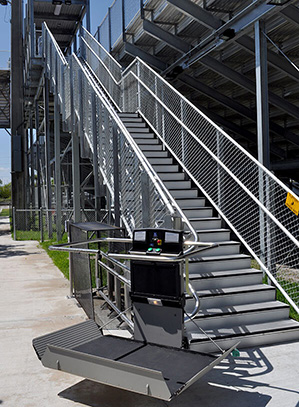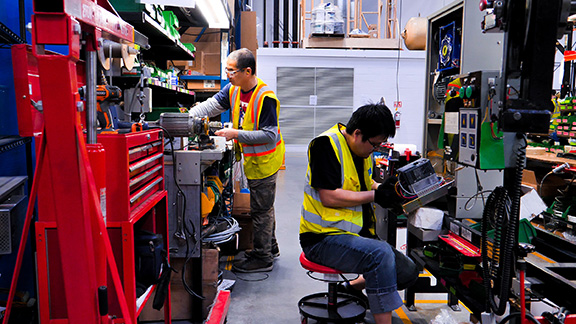Volume 26 | Issue 2
Click here to read the complete illustrated article or continue below to read the text article.
The origins of Garaventa Lift dates back to 1928 when Karl Garaventa began building cable cars to traverse the Swiss Alps. That notion of mobility grew into a global leader of custom lift solutions for commercial and residential applications to improve accessibility. Acquired by the Savaria Corporation in 2018, the combination of Savaria and the Garaventa Lift Group created an industry leader offering a global distribution network and one of the most comprehensive portfolios of accessibility products available today.
A significant part of that global group, Garaventa Lift North America is one of the largest accessibility and mobility companies in the hemisphere, with an extensive product portfolio of platform lifts, seat lifts, and elevators. Established 45 years ago and currently with over 500 employees, Garaventa Lift North America is headquartered in British Columbia, with experienced and certified product consultants working with architects, builders, and homeowners throughout Canada and the United States.

Vince Sciamanna, president of Gravental Lift North America for the past six years, traces the company’s steady growth back to the passage of the North Americans with Disabilities Act. “Garaventa Lift long ago saw the potential of using ski lift technology to provide a smaller version to help people go up and down stairs within private homes and public buildings. The next step in that evolution was wheelchair-accessible commercial building elevators, followed by private residential elevators,” he says. “Today, we’re seeing more inclusive designs for new construction, especially during the last 10 years, that include elevators, even for residents who are not disabled, but expect to live in place long term with the possibility that it might be needed some time in the future.”
You might think a personal elevator is a luxury for the affluent, but Sciamanna notes that, “While we have $200,000 elevators with a lot of cosmetic and feature upgrades, we can also build elevators at about $25,000, with the ability to easily lift four to five people, and with a lot of selection in between. Cost varies according to such factors as the size and weight of the elevator, the number of floors where the elevator stops, and the total travel distance. The application is always the same, to act as an elevator, but uses differ. In some cases it is just a practical matter of providing accessibility, in others it could be a sleek feature of high-end architecture. The underlying technology is the same.”
While Graventa Lift elevators share many of the same commercial components, two factors are driving down the price compared to 20 years ago. “Electric motors as opposed to hydraulic systems are less costly,” he says,” and are easier to operate. All the user has to do is push a button. Hydraulics push the elevator up using a piston, while an elevator with an electric motor raises up using a pulley. The electric elevator doesn’t require complex components and gears, making it less expensive. It is also less noisy, provides a smoother ride, and is more suitable for narrow spaces, which makes it ideal for personal residences.”
Which is not to say, Sciamanna is quick to point out, that hydraulic elevators don’t have their place. “Our traditional hydraulic LULA elevator offers many premium features and advantages, including a design that minimizes the space required for technical equipment. It seamlessly integrates smooth, quiet operation and ultra-reliable performance with a stylish interior. Energy-efficient features and efficient installation that eliminates the need for hydraulic fluid and a costly oil separator in the floor drain makes the LULA an eco-friendly choice.”

Garaventa Lift elevators are assembled in Vancouver, British Columbia, in a facility staffed by 300 employees, and installed by local certified subcontractors on-site. “We source various components—such as doors and motors—from leading manufacturers around the world. We design and manufacture the controller components. Taken together, use of the parts combined with expert design and installation enable us to offer a seven year warranty, the best available warranty in the industry.”
He adds, “Every accessibility solution and project is customized by our designers based on the characteristics of the home or building and the individual needs and desires of the user.” Typically, he explains, Garaventa Lift works with architects and builders, as well as consulting with the American Institute of Architects (AIA) Continuing Education System about how lifts and elevators enhance life quality and end user safety.
“We provide architects, builders, and installers with detailed, site-specific drawings that itemize instructions such as exact dimensions, the location of hoistway openings, and power requirements,” Sciamanna notes. “Our vast network of consultants carry out inspections and provide free estimates throughout North America.” The final stage of installation is a training and turnover session. “The local Garaventa Lift representative demonstrates how to operate the lift or elevator, what to do in case of emergency, and how to arrange for regular maintenance and service,” Sciamanna says, also emphasizing that, “A proper preventative maintenance program is required to maintain the equipment in proper and safe operating condition and extend equipment lifespace.”
Just one example of Garaventa Lift’s innovative design combined with practical accessibility is a recent project cited by the company as a project of the month at a private residence in downtown Ottawa. “Canada Elevators installed our Elvoron HR Home Elevator, which features a glass cab with stainless steel glass 3-speed doors at each landing. This elegant elevator combines both aesthetics and functionality, providing residents with a convenient and luxurious mode of vertical transportation within their homes,” Sciamanna says.
Another is the Genesis Shaftway elevator model installed by Garaventa partner Access Outfitters at the Quinns Hot Springs resort in Montana. According to Sciamanna, “What makes this project truly exceptional is the seamless blend of form and function. It’s not just an elevator, but an integral part of the resort’s ambiance.”
With an aging population of boomers, combined with ADA standards for accessible design, Sciamanna believes that the elevator business is, well, going up.
In this episode, I sat down with Beejan Giga, Director | Partner and Caleb Emerson, Senior Results Manager at Carpedia International. We discussed the insights behind their recent Industry Today article, “Thinking Three Moves Ahead” and together we explored how manufacturers can plan more strategically, align with their suppliers, and build the operational discipline needed to support intentional, sustainable growth. It was a conversation packed with practical perspectives on navigating a fast-changing industry landscape.